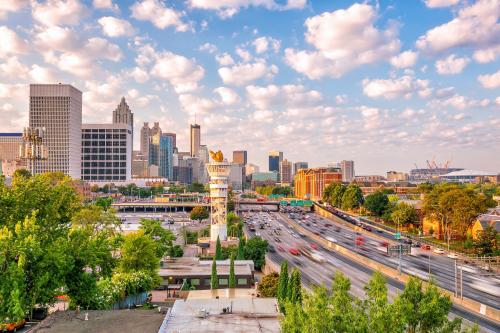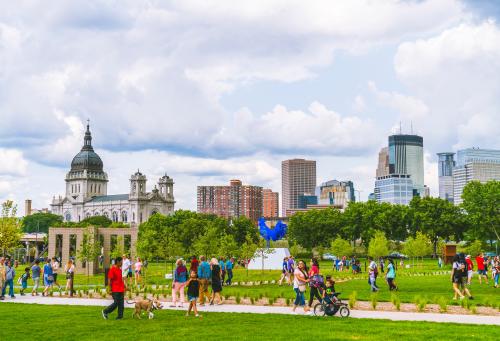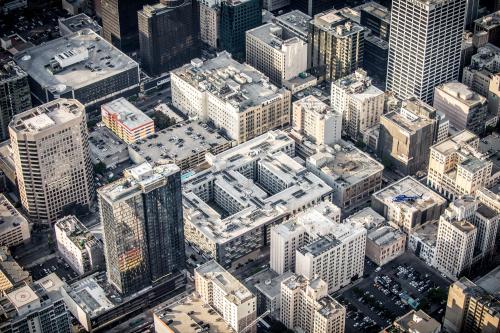Summer offers a time to relax and recharge, and that often includes a chance to connect with nature. Getting outside in the warmer months reminds us how important green space is to our individual health and community well-being, especially for city and suburban residents who may be more detached from nature.
This is the vital role parks play in metropolitan America. They are one of the country’s most foundational civic assets, providing many environmental, social, and economic benefits. Investments in parks—through improved infrastructure, community engagement, and other place-based strategies—can also address long-standing social and economic divides. The fact that knowledge workers and young jobseekers want to live near parks only reaffirms the importance of these investments.
Park access should be a driver of more livable and equitable communities across the country, supporting common spaces for recreation, interaction, and trust. But parks can only reach their peak potential if every household can access such green space, and that access shouldn’t be tied to a private vehicle or an unreasonable walking distance.
At the city level, researchers have long confirmed that park access is unequal. The size and location of parks can vary greatly from place to place, and a third of Americans in the 100 largest cities are more than a 10-minute walk from a park. City residents may also remain disconnected from parks depending on their income, education, and race.
By using park data organized by the National Environmental Public Health Tracking Network, we can see the share of residents living within half a mile of a park in metropolitan areas. These regional analytics confirm unequal park access extends beyond city borders, creating another form of environmental injustice.
Among the 100 largest metro areas, almost 54% of residents live within half a mile of a park, but there is considerable range depending on the market. On the high end are western metro areas such as Denver, Portland, Ore., and Provo, Utah, where more than two-thirds of residents live near abundant natural amenities. Also ranking high are metro areas such as Washington and Minneapolis, both known for having extensive park systems. On the low end are sprawling metro areas concentrated in the southeast, including Atlanta, Birmingham, Ala., and Knoxville, Tenn., where under a third of residents live close to parks.

There are several spatial and economic factors at play here, but these factors are highly specific to individual regions, in line with previous research on this topic.
Consider population density and age, for instance. Regions with greater density foster closer civic connections and intensify the need for walkable access to nature. As shown below, population-dense counties located in the urban core of the country’s largest metro areas tend to deliver the greatest park access (nearly 64%). Access begins to decline in smaller metro areas and older suburbs, before dropping even further in the newest suburbs and exurbs. Clearly, older and denser counties put people in closer proximity to parks.

However, job-dense metro areas do not display the same consistency. As a recent Brookings report has shown, job concentration is increasing, especially in large metro areas, where there are nearly 26,000 jobs per square mile, up 30% since the early 2000s. Job-dense metro areas such as San Francisco (54,375 jobs per square mile), Chicago (42,428 jobs), and Seattle (35,122 jobs) all have high shares of residents with park access (over 70% each), but the same isn’t true in other job-dense metro areas such as Pittsburgh (46%) and New Haven, Conn. (48%). Generally, there is a positive relationship between job density and park access, but the scatterplot below displays some of this variability across the country.

Another potential trend: regions with lower park access tend to have higher poverty rates. Nearly 14% of residents in the 100 largest metro areas live in poverty, and many live far away from parks and remain disconnected from opportunity. In fact, the 10 metro areas with the lowest park access all have above-average poverty rates. McAllen, Texas has both the lowest park access (11%) and highest poverty rate (32%), but several other metro areas don’t fare much better, including Greenville, S.C., Jackson, Miss., and Scranton, Pa. Still, there can be variability depending on the particular market, as demonstrated below.

These examples only scratch the surface of how park access varies nationally, but the findings highlight the urgency to understand park access at the metropolitan scale. With suburbs once again growing faster than their city peers, and suburbs hosting the majority of people living in poverty, limited park access along the metropolitan fringe is a genuine barrier to household well-being for too many people. In response, metropolitan areas need regional plans to bring parks closer to all residents.
Fortunately, the shift toward placemaking principles offers a powerful solution. Increased walkability and urban connectivity, for instance, has jumpstarted planning efforts (and market demand) in dense, mixed-used neighborhoods. These kinds of neighborhoods tend to put residents in close proximity to parks. Moving forward, local planners and real estate developers can use placemaking principles to reduce spatial and economic barriers tied to park access.
Parks should represent a bridge—not a gap—in supporting great places for everyone.







Commentary
Parks make great places, but not enough Americans can reach them
August 21, 2019